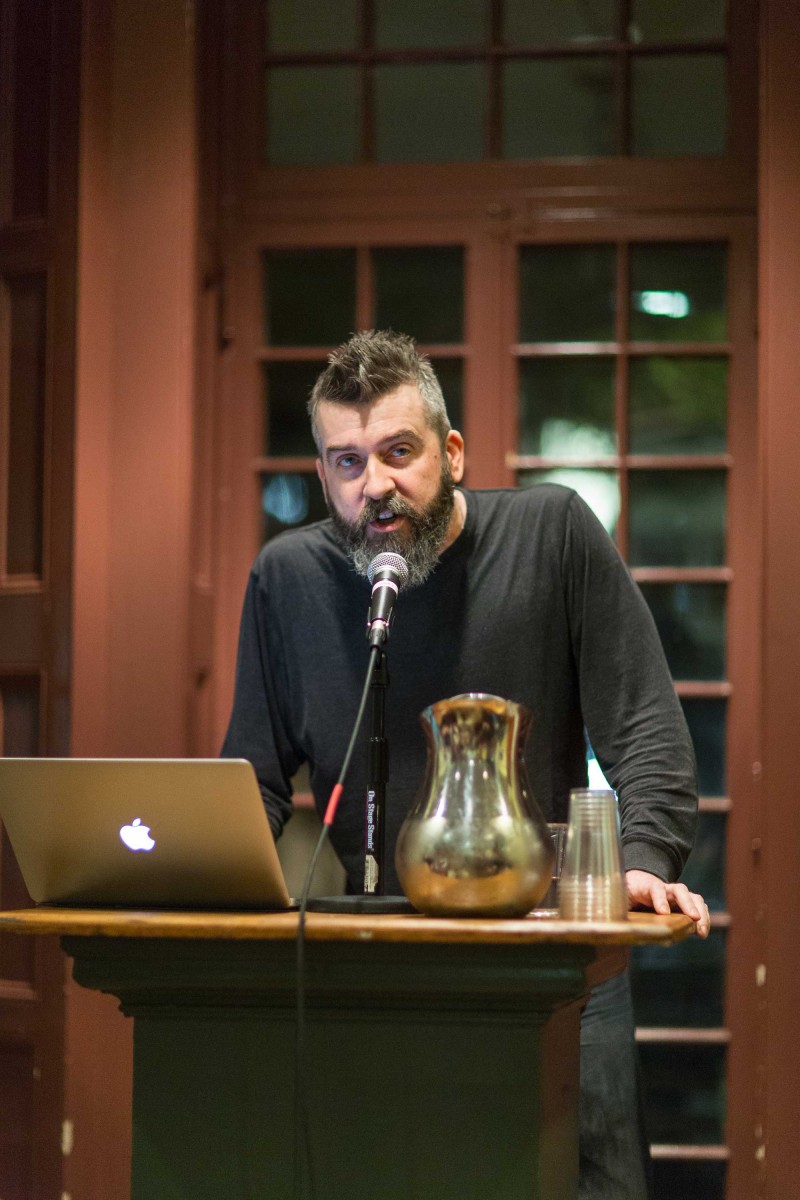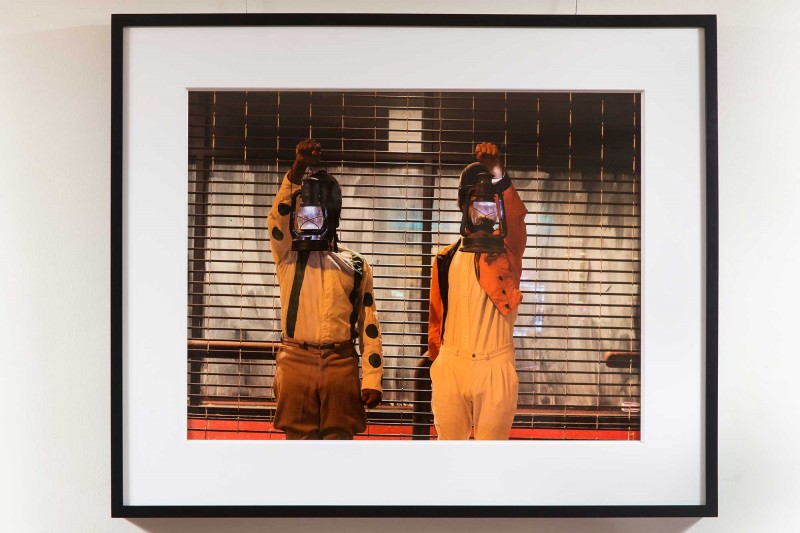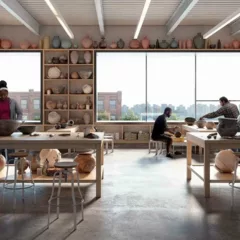Does a multicultural society need political art? The answer from the organizers, artists, and poets of the multi-city exhibition and event series Organize Your Own is a truly positive one. Engaging with the history of the Civil Rights movement in the United States and echoing anti-racist ideas from the 1960s and 1970s, the project interconnects questions of racism, identity, and community with the current Black Lives Matter movement and issues of migration. I hoped to find at Organize Your Own truths about the relevance of political art. But rather than simply revealing truisms, Organize Your Own opens a window of self-reflection in which we feel encouraged to organize our own beliefs.
Ancestry, community, and the intersection of art and politics
Curator Daniel Tucker, who organized the project and heads Moore College of Art and Design’s new master’s degree programs in community art practice, invited 10 visual artists and five poets and performers from Philadelphia and Chicago to respond both to archival materials related to the history of the Young Patriots Organization (Chicago) and the October 4th Organization (Philadelphia) and to a general concept of self-determination. Among the results are prints that are exhibited in the cozy setting of the Kelly Writers House. Between books, sofas, and tabletops holding various publications, the artworks smoothly integrate into the center for writers, and at the exhibition’s opening last Thursday, the print works were refined with performances by the writers Salem Collo-Julin, Marissa Johnson-Valenzuela, and Frank Sherlock (all Philadelphia), as well as the duo Thomas Graves (Austin) and Jennifer Kidwell (Philadelphia).
Perhaps the most striking issues raised at the event were questions about ancestry and community. I was taken with the following four prints and poems—visible and audible at the opening and whose cumulative effect initialized deeper thoughts about the conjunction of art and politics, of the artistic production and cultural impact.

“Status Quo Visitor Survey” is an interactive print by Rosten Woo (Los Angeles) who invites the audience to participate in a survey on the demographic background of the Kelly Writers House’s public. Visitors at the opening placed actual map pins on the wall-mounted survey, adding data they felt best described in their personal circumstances and with their professional talents. Over the course of the evening, the survey filled with information provided in this peculiar hands-on study, which seemed at first glance generally practical in the idea of an institution collecting its guests’ background and wishes. However, while hesitating over the exposed situation—Do I really want to show my income on the board?—I observed that the survey unsurprisingly reveals that most visitors are white, liberal-oriented, and related in some way to artistic professions. These results aren’t really new; in fact they draw a parallel to Hans Haacke’s survey of visitors of the John Weber gallery in New York in the early 1970s. But in this artwork, Rosten Woo is not so much collecting data as he is encouraging our general suspicions of the survey’s validity and of the institution’s outreach to obtain it. While the results also reminded me of the gentrified neighborhoods in West Philadelphia, occupied by institutions such as the University of Pennsylvania or Drexel University, the practical consequence of his critique seems simply reasonable: Shouldn’t we be outraged about urban segregations and the limits of multicultural exchange?

In the poem “No Border No Cry,” which the Irish-American poet Frank Sherlock read this evening, he sarcastically pointed out that personal identity is shaped by our will to engage and our ability to remember. While calling us to forget the oppressive burden of history, become rebellious, but still remember the past, he reclaims the power of self-determination. Furthermore, Sherlock recalls art and poetry not as side effects but gives them back the crucial role that they play and played in the social movements then and today. Bringing words to the people, poets, and writers helps to express a social-political resistance.
Calling for sun
The idea of raising a voice against racism and capitalism also permeated the reading by Marissa Johnson-Valenzuela. The artist and DJ reflects in her prose on her experience as a citizen of, and activist in, West Philadelphia and detects in the political culture today a decline from collective activism to critical observation, calling it “beige resistance”. Her claim for more imagination and activism reminds me of Joseph Beuys’ concept of social sculpture, in which people are supposed to contribute creatively and collectively to a better society. Calling in 1982 for Sonne statt Reagan—sun rather than Reaganite rain [in German, Regen]—the liberal artist Beuys activated a discourse about art as an instrument to reflect on and transform social-political questions that remain powerful today.

A figurative protest against social segregation and exclusion is staged in the photo series Urban Space Jockeys by the artist collective Amber Art & Design. The three exhibited artworks are questioning indeed the limits and permeability but also dependence among communities. The photographs show black men in jockey attire, who are illumining each other or the street in front of them with historical petroleum lamps, which obviously relate to the countryside and the world of wealth. However, their dress is a disguise and the figures seem displaced in the urban surrounding of Philadelphia’s Lancaster Avenue, where the performance was staged and the photos shot. Blending black and white communities into each other, the photographs reveal crucial disparities. Though deliberately mingled, social structures are still ambivalent and groups are still principally separated in different areas—not even the metaphor of enlightenment ideals suggested by the lamps’ illumination seems helpful. However, the social need for each other and amalgamation of humans is inevitable. As Martin Luther King, Jr. said in 1967: “…the black man needs the white man and the white man needs the black man… We are bound together in a single garment of destiny.”
In addition to the examples above, the exhibition presents artworks and poetry by many contemporary artists from around the country. In particular, Dan S. Wang’s upcoming workshop and panel discussion “Falling In” shouldn’t be missed in February at the Asian Arts Initiative. The artist amplifies the perspective from topics about racism and identity to the continuous flood of migrants to the United States in the present day. Working with students from China, Wang engages not only with the question of the necessity and effect of political art, but also interconnects the project to bigger questions of migration and cultural integration today.
To extract a general issue about the relevance and agency of political art from the exhibition and opening performances seems to me too much. What the artists’ projects in Organize Your Own reveal is that they are neither only preoccupied with art’s formal aesthetic dimensions nor only committed to a political articulation, as Hammam Aldouri describes the basic dichotomy between pure art and political art practice in his essay “On immanence (2)”. But they give us something to think about. Political art is in this sense, rather, the freedom of the arts to blur the boundaries between life and art; to reveal critically; to get involved with social-political issues. Political art is also the freedom to question and comment with humor, irony, and anger on unpleasant affairs concerning human activities. The political art product might not be an immanent active one, but its power seems to lie in the possible artistic influence to gradually transform social-political thinking. Hence the question still should be: How do we want to organize our own within global changes?
Organize Your Own will be on view until Feb. 17, 2016 at the Kelly Writers House at the University of Pennsylvania (3805 Locust Walk, Philadelphia, PA 19104) and will travel in March to the Averill and Bernard Leviton Gallery in Chicago. Check out the project’s calendar for the upcoming events.
Further reading
Forget Fear. 7th Berlin Biennale, ed. by Artur Zmijewski and Joanna Warsza, Cologne, 2012.








